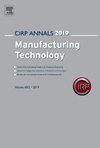Nanometric cutting of plasma modified polycrystalline tin
IF 3.2
3区 工程技术
Q2 ENGINEERING, INDUSTRIAL
引用次数: 0
Abstract
Soft and low-melting-point polycrystalline tin holds considerable promise in the field of advanced lithography. However, its machinability is significantly hindered by the grain size, posing substantial limitations on its practical utility. Herein, a novel approach involving oxidation-enhanced plasma modification is presented to obtain a grain coarsening layer, thereby enhancing machinability. The effects of cutting mode and feed rate are examined, revealing that plasma modification results in the formation of a millimeter-scale grain coarsening layer. Consequently, the tin surface with a surface roughness of 0.98 nm in Sa after cutting is effectively achieved, benefiting applications in ultra-short light wavelength sources.
等离子体改性多晶锡的纳米切割
软质低熔点多晶锡在先进光刻技术领域大有可为。然而,其可加工性受到晶粒尺寸的严重阻碍,对其实际应用造成了很大限制。本文提出了一种涉及氧化增强等离子体改性的新方法,以获得晶粒粗化层,从而提高可加工性。研究了切削模式和进给量的影响,发现等离子改性可形成毫米级的晶粒粗化层。因此,切割后表面粗糙度为 0.98 nm(Sa)的锡表面得以有效实现,有利于在超短波光源中的应用。
本文章由计算机程序翻译,如有差异,请以英文原文为准。
求助全文
约1分钟内获得全文
求助全文
来源期刊

Cirp Annals-Manufacturing Technology
工程技术-工程:工业
CiteScore
7.50
自引率
9.80%
发文量
137
审稿时长
13.5 months
期刊介绍:
CIRP, The International Academy for Production Engineering, was founded in 1951 to promote, by scientific research, the development of all aspects of manufacturing technology covering the optimization, control and management of processes, machines and systems.
This biannual ISI cited journal contains approximately 140 refereed technical and keynote papers. Subject areas covered include:
Assembly, Cutting, Design, Electro-Physical and Chemical Processes, Forming, Abrasive processes, Surfaces, Machines, Production Systems and Organizations, Precision Engineering and Metrology, Life-Cycle Engineering, Microsystems Technology (MST), Nanotechnology.
 求助内容:
求助内容: 应助结果提醒方式:
应助结果提醒方式:


